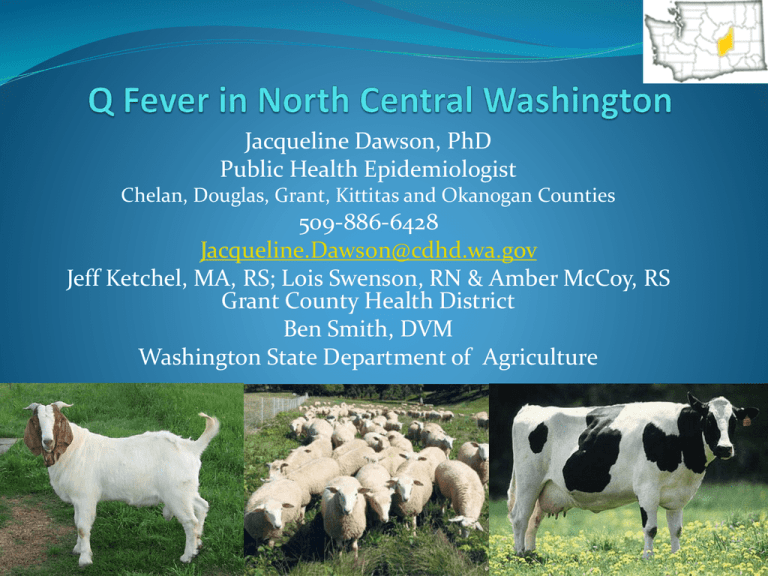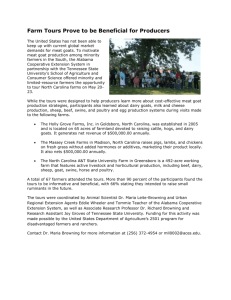Washington State Departments of Agriculture and Health
advertisement

Jacqueline Dawson, PhD Public Health Epidemiologist Chelan, Douglas, Grant, Kittitas and Okanogan Counties 509-886-6428 Jacqueline.Dawson@cdhd.wa.gov Jeff Ketchel, MA, RS; Lois Swenson, RN & Amber McCoy, RS Grant County Health District Ben Smith, DVM Washington State Department of Agriculture History 1935 Queensland, Australia Montana 2012 Worldwide Outbreaks Military troops Cities and towns Downwind from farms Next to roads traveled by animals www.cfsph.iastate.edu The Organism Coxiella burnetii Bacteria Grows inside cells Spore-like Stable and resistant Category B bioterrorism agent: long-term environmental stability =weeks to years resistance to heat and drying extremely low infectious dose (1 bacteria) aerosol infectious route Killed by pasteurization Transmission Aerosol Placenta and birth fluids Urine, feces, milk Direct contact Surfaces Ingestion Ticks Human-to-human extremely rare Ingestion (mainly drinking raw milk) is probably a minor factor in the transmission of C. burnetii and a point of controversy. http://www.ncbi.nlm.nih.gov/pmc/articles/PMC88923/ Animal Disease Sheep, cattle, goats, cats, dogs, some wild animals (including rodents), birds and ticks. Localizes in: mammary glands supramammary lymph nodes placenta uterus, from which it may be shed in subsequent parturitions and lactations May be asymptomatic Reproductive failure Abortions Stillbirths Retained placenta Infertility Weak newborns Low birth weights Carrier state Acute Infection The bacteria can cause a sudden onset of: High fever (104 F) with shaking chills (night sweats) Vomiting, diarrhea, abdominal pain and chest pain Muscle and joint pains Severe headache (often behind the eyes) Extreme fatigue Flu-like symptoms that usually last for 2-6 weeks Pneumonia (30 to 50%) Hepatitis (33%)= liver inflammation Skin rash (10%) Other signs (< 1%) Myocarditis, meningoencephalitis, pericarditis Death: 1 to 2% Chronic Disease 1 to 5% of those infected Prior heart disease pregnant women Immunocompromised (ex: Cancer therapy) Endocarditis (infection of a heart valve) Poor liver function Bone infection 50% relapse rate after antibiotic therapy Risk to Pregnant Women Most asymptomatic Transplacental transmission Reported complications In-utero death Premature birth Low birth weight Where is it? The true incidence is unknown in the Pacific Northwest. WSU is currently conducting a study to determine the geographic distribution and goat herd prevalence. Epidemiology Occupational and environmental hazard Farmers Livestock producers Veterinarians and technicians Meat processors/ abattoir workers Laboratory workers Treatment GOATS Treatment: Oral tetracycline at the therapeutic dose may be given for 24 wk. In known infected herds administering tetracycline (8 mg/kg/day) prophylactically in the water supply prior to parturition may reduce spread of the organism. Merck Veterinary Manual HUMANS Treatment Doxycycline Chronic disease – long course 2 to 3 years of medication Immunity Long lasting (possibly lifelong) Lab testing for Q fever Serology = CF or ELISA Detects antibodies produced against bacteria LIVE bugs?= Culture at CDC Risk to laboratory personnel PCR = polymerase chain reaction Detects and amplifies the bacteria (LIVE or DEAD) Polymerase Chain Reaction = PCR Phase I vs II Antibodies During the course of the infection, the outer membrane of the organism undergoes changes in its lipopolysaccharide structure, called phase variation. Acute: Higher Phase II antibody titers Not very infectious Chronic: Higher Phase I antibody titers Highly infectious http://www.ncbi.nlm.nih.gov/pmc/articles/PMC88923/ Q fever in Washington, 2011 Producer wanted to know the source of abortions in goat herd Placenta sent to WSU by local Vet Producer assisted with tracing herd sales in WA, OR and MT Coxiella burnetii organisms (red) within infected placenta cells (blue) Washington State Study Humans: 61 samples were collected from Producers/family and Agriculture personnel Goats were tested from 13 farms in 7 counties: Adams, Chelan, Clark, Franklin, Grant (N=6), Pend Oreille & Thurston Samples were collected by WSDA & USDA Vets: 326 Blood samples 312 Vaginal swabs 108 Fecal swabs 37 Milk samples Environmental samples were taken from a few farms Results From All Washington Farms PEOPLE: 11 / 61 (18%) had positive serum samples 7 / 11 (64%) people were sick 4 / 11 (36%) people were not sick All Vets and Extension service personnel were negative Most Producers were negative, even on goat positive farms 5 / 11 Grant County: 4+ (3 ill) in a family with meat goats since 2007 All goats PCR negative (including goat from Farm A); 9% ELISA + 1 + recently moved to WA: raised goats, sheep and cattle whole life Bought dog from Farm A; goats and sheep from other farms GOATS: 8% goats were ELISA + 10% fecal swabs (males) were PCR + 31% of vaginal swabs were PCR + All whole blood samples were PCR negative All 19 + milk samples were from one non-milk producing farm Animal Tracing ? 3 positive does on one farm were not from Farm A One positive had never been off of the farm Does bred at Farm A were ELISA and PCR negative Q fever is ubiquitous, so positive animals should be found throughout the state WSU conducting study of goats around WA Farm A Farm X 2011 Environmental Results CDC isolated live Coxiella burnetii from the WA goat placenta and a vaginal swab taken from a Montana goat. The 2 isolates and a WA environmental sample are in the same genetic group (sequence type 8). Type 8 was previously seen in a chronic human Q fever case in Washington State with no connection to goats. Type 8 has also been found in several other goats and chronic human cases in the US. Presence of Coxiella burnetii DNA in the Environment of the United States, 2006 to 2008 http://aem.asm.org/content/76/13/4469.full.pdf+html CDC found Q fever bacteria in environmental samples from post offices, stores, schools, farms, dairies and fairgrounds Rocky Mountains- 45% South Central – 36% Upper Midwest – 25% Deep South – 16% West Coast – 14% East Coast – 6% Some areas had up to 50% positive samples Best Practices to Control Q Fever National seroprevalence: 41.6% of sheep 16.5% of goats 3.4% of cattle http://www.merckvetmanual.com/mvm/index.jsp?cfile=htm/bc/52000.htm Prevention and Control Eradication not practical Too many reservoirs Constant exposure Stability of agent in environment WSDA: Best Practices to Control Q Fever http://agr.wa.gov/FoodAnimal/AnimalHealth/Diseases/QFeverManagementPractices.pdf When is the most risk ? 2 weeks prior to one month after birth Lactation Abortions Placentas Birth fluids Kidding/lambing/calving barns Where is the most risk? • Highest risk is due to contact with birth products such as placentas, birth fluids, etc. • • • • Use disposable gloves Barn only clothes Mask to reduce airborne bacteria in dust Remove any dead fetuses and placentas as soon as you can in plastic bags and burn or bury at least 3 feet • Compost and spread on fields • Risk of selling manure • Immediately clean birthing areas then apply 10% Bleach, 5% Hydrogen Peroxide, or 1% Lysol • 30 minute contact time • Keep down dust Farm Biosecurity Limit access for visitors People with high risk to contract it are immune compromised, pregnant women, and heart valve patients Wash hands and arms after animal contact Keep barn clothes out of the house Clean and disinfect boots Farm Biosecurity Maintain good records of animal movements If your animal aborts, contact local veterinarian and save everything you can, especially placenta, for diagnostic evaluation Culling of animals based on blood tests is not recommended and won’t ensure a negative herd. 2 Kidding Seasons C. burnetii infection in goats seems to be limited to two kidding seasons. Natural History of Q Fever in Goats Todd Hatchette The Department of Medicine, Dalhousie University, Halifax, Nova Scotia Nancy Campbell, Robert Hudson, Didier Raoult, Thomas J. Marrie March 2003, Vol. 3, No. 1, Pages 11-15 Posted online on July 9, 2004. Conclusion Q fever is everywhere. Individual antibody test of little value. Q fever can not be traced to any one source with any reliability. All farms had multiple sources of animals or bred animals at multiple farms. The number of antibody positive animals in this investigation (8%) was lower than that of previous studies. Resources Many links on our website www.agr.wa.gov Sublinks to CDC and university websites on: Composting Manure and animals Disinfection Basics of different products and what they will work on Boot cleaning Hand washing Acknowledgements Centers for Disease Control and Prevention Center for Food Security and Public Health at Iowa State University USDA- veterinarians and laboratorians WSU- Field Disease Investigative Unit, Extension Service and Lab Local county health jurisdictions





